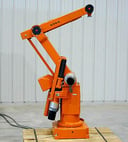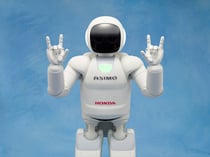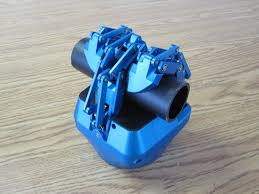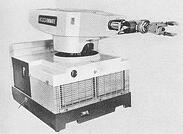Robotics' History: From GM Work Floor to Collaborative Robots

Posted on Apr 24, 2015 in Robotics
5 min read time
A couple of weeks ago I saw this video from the SciShow and I thought: THAT would be a great blog article. Most of our readers have been swimming in the actual robotic world, yet I am pretty sure that most of us don't really know the history behind all the robotic evolution we experience daily. Well, here we go, I have put together some kind of a timeline to remind you where robots started and the road that we have travelled. The future however is up to you!
But for now take a look at this funny video from the SciShow.
1961
The first industrial robot (UNIMATE) is installed in a General Motors automobile factory in New Jersey. The assembly line robot is controlled step-by-step by commands stored on a magnetic drum; the 4,000-pound arm sequenced and stacked hot pieces of die-cast metal. The robot was a work in progress by George Devole and Joe Engleberger - since 1954, nearly 70 years!
1963
The first artificial robotic arm to be controlled by a computer is designed at Rancho Los Amigos Hospital in Downey, California as a tool for the handicapped. The Rancho Arm’s six joints gave it the flexibility of a human arm. Stanford University acquired the arm that same year. The robot arm was featured in the film Demon Seed in 1977, Yikes!
1969
Victor Scheinman, a Mechanical Engineering student working in the Stanford Artificial Intelligence Lab (SAIL) creates the Stanford Arm. It was the first successful electrically powered, computer-controlled robot arm. By 1974, the Stanford Arm could assemble a Ford Model-T water pump, guiding itself with optical and contact sensors.
1974
ASEA, the Allmänna Svenska Elektriska Aktiebolaget (English translation: General Swedish Electric Company) who later merged with the Swiss company Brown, Boveri & Cie to form ABB designed IRB 6 for material handling tasks. The robot allowed movement in 5 axes with a lift capacity of 6 kg. It was the world's first fully electrically driven and microprocessor-controlled robot, using Intel's first chipset.
1982
Fanuc of Japan and General Motors form a joint venture: GM Fanuc. The new company is going to market robots in North America. The new company was 50 percent owned by each partner and was based in Detroit, with GM providing most of the management and Fanuc the products. By linking up with its largest single potential customer in the United States, Fanuc all but assured itself of a lucrative share of the U.S. market. Smart move that!
1986
LEGO and the MIT Media Lab collaborate to bring the first LEGO-based educational products to market. Precursor of the ever popular Mindstorms.
Honda begins a robot research program that's starts with the premise that the robot "should coexist and cooperate with human beings, by doing what a person cannot do and by cultivating a new dimension in mobility to ultimately benefit society". They start with the experimental “E-series” between 1986 and 1991.
1997
The first RoboCup football tournament is held in Nagoya, Japan.
The Pathfinder Mission lands on Mars. Its robotic rover, Sojourner, rolls down a ramp and onto Martian soil in early July. It continues to broadcast data from the Martian surface until September, fully 3x longer than anticipated.
 2000
2000
Honda debuts a new humanoid robot, ASIMO, the next generation of its series of humanoid robots.
The UN estimates that there are 742,500 industrial robots in use worldwide. More than half of these are being used in Japan.
2001
Built by MD Robotics of Canada, the Space Station Remote Manipulator System (SSRMS, also known as the Canadarm) is successfully launched into orbit and begins operations to complete assembly of the International Space Station.
2004
The first DARPA Grand Challenge race is held. This race for autonomous ground vehicles over 143 miles in the desert south-west of the United States is called off after the most successful team made it only 7 miles. Not unproductive however, as present day driverless cars can be traced to the innovation sparked by this challenge.
The United Nations Economic Commission for Europe (UNECE) estimates the number of installed robots to be around 800,000 (not counting small service or entertainment robots).
 2008
2008
Robotiq launches its first version of the 3-Finger Adaptive Gripper. The project that came out of the Robotics Laboratory at Laval University, Quebec, Canada.
2009
Universal Robots launches its first version of the UR5 collaborative robot, initially available only on the Danish and German markets.
2012
The DARPA Robotics Challenge (DRC) is a prize competition funded by the US Defense Advanced Research Projects Agency. The goal is to develop semi-autonomous ground robots that can do ‘complex tasks in dangerous, degraded, human-engineered environments’.
A UNECE/IFR (International Federation of Robotics) pilot study indicated that the global robotic population is over one million…actually 1,235,000.
After this things really start to explode exponentially, so it is quite hard to note down everything that has happen. Indeed I must have neglected or forgotten some of your special robot projects. Robotics is a very wide market and it is spread across the global scene. It is certainly hard to be aware of everything. However, I suggest that you tell us of anything we’ve forgotten. You can leave a comment and tell us what you consider the real deal or your turning point in robotics. We will add it to the article so we can build a really solid robotic history.



 2000
2000 2008
2008






Leave a comment